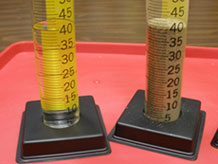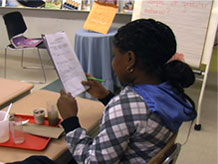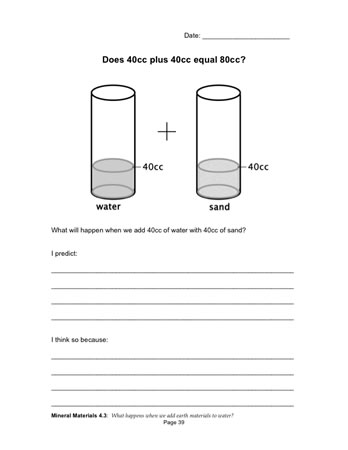What happens when we add earth materials to water?
Plan Investigation 4.3

Cheerios … jellybeans … sand … gravel. What do these things have in common? They are all granular materials, assemblages of individual pieces or grains with "empty" spaces between them. Unlike solids and liquids, granular materials have three volumes: the volume of the solid material, the volume of the space between the grains, and the combined bulk volume.
In this investigation, students continue their investigation of volume and water displacement by adding solid, liquid, and granular materials to water and recording the volumes that result. By the end of the lesson, students will understand that the volumes of solids and liquids can be added directly. However, when a granular material is added to a liquid, the combined volume is equal to the sum of the separate volumes minus the volume of the air between the grains in the sample.
Learning Goals
- Become familiar with a graduated cylinder
- Understand that the volumes of solids and liquids can be added together
- Understand that granular materials displace water differently than solids and liquids
| Sequence of experiences | ||
|---|---|---|
| 1. Ask the question | All Class | 10 Mins |
| 2. Explore volumes in water | Small Groups | 20 Mins |
| 3. Make meaning | Discussion | 15 Mins |
Materials and Preparation
For the class:
- Post the investigation question in a place where all students can see it.
- 1 strainer (for clean-up)
- 1 50cc graduated cylinder filled with 40cc of water
- 1 100cc graduated cylinder filled with 40cc of sand
- 10 centimeter cubes
For each tray:
- 1 cup holding at least 40 centimeter cubes
- 1 20oz cup for use as a "waste bucket"
- 2 plastic forks
- 2 pipettes
- 2 3oz cups approximately two-thirds full of bulk gravel
- 2 20oz cups approximately half full of water
- 2 50cc graduated cylinders
- 2 140cc graduated cylinders - student-made measuring cups, from Investigation 3.2
- 2 rocks or minerals that will fit in the cylinders; sandstone or granite works well
- 4 paper towels
Concept Cartoon

The Volume Concept Cartoon is typically used as a formative assessment at the end of this investigation.
1. Ask the question

Let students know they have come a long way measuring their earth materials.
- They know how to find the weight of materials using a digital scale.
- They know how to find the volume of liquids using their measuring cups.
- They know how to find the volume of objects by observing how much water they displace.
Today they will get more practice finding volumes using the water displacement method, and they will find the volume of some new earth materials: gravel and sand. They will also learn how to use a new instrument — a graduated cylinder.
Show the class the 50cc graduated cylinder with 40cc of water in it. Explain that scientists use graduated cylinders to measure liquids and solids, much as the students did when they used their "measuring cups" to measure water samples — and when they used the containers to measure the volume of rocks in the last session. Explain that graduated cylinders come with measuring lines already marked on them. Pass around the cylinder.
- What is the unit of measurement?
- How much water is there in the cylinder right now?
Four key understandings:
- Two objects cannot occupy the same space at the same time.
- Objects that are submerged in water will displace water (push it out of the way and take its place) and this raises the water level.
- The more space the submerged object takes up, the higher the water level rises.
- The amount of water displaced by a submerged object is equal to the volume of the object.
Check students' understanding of the relationship between volume and water displacement.
- What do you think will happen to the water level if we put 10 centimeter cubes into this graduated cylinder?
- How much will it rise? What marking will the water reach on the graduated cylinder?
Check students' predictions by dropping 10 cubes into the cylinder.
- What if we dropped in 15 centimeter cubes? 20? What about a rock with a volume of 30 cubic centimeters? How would that affect the water level?
Students will likely propose that the water level will rise to a level that equals the sum of the water volume and the material volume. If not, review the principles in the boxed note.
Call attention to the investigation question:
What happens when we add earth materials to water?
2. Explore volumes in water

Distribute a tray of materials to each group. Point out that the graduated cylinders are the same "measuring cups" that the students made to measure water volumes in an earlier investigation.
Ask students to open their notebooks [What happens when we add earth materials to water?] and review the list of materials they will add to water in their graduated cylinders: centimeter cubes, water, rocks, and gravel. Explain that they will investigate one material at a time, and that they will start with a fresh measure of water (40cc) each time they change materials. They can work in pairs.
Before students get to work, remind them to predict how much the water level will rise with the addition of each material. Students can make their predictions in their notebooks, or they can make predictions with their partners. In either case, they should explain their reasoning. Model this kind of conversation with a volunteer:
- What do you predict will happen when we put 10 centimeters cubes in 40 cubic centimeters of water?
- I predict that when I put 10 centimeter cubes in the water the water level will rise to 50 cubic centimeters.
- Why do you think so?
- Because the water and the cubes can't be in the same place at the same time, and the cubes will push the water up.
The investigation is straightforward. Students add measured volumes of material to 40cc of water and observe the change in volume in the graduated cylinder. The results for the first three tests are straightforward, too. The combined volume is equal to the sum of the separate volumes.
But the gravel is a different story. When students add 40cc of gravel to 40cc of water, the combined volume is considerably less than the sum of the two.
40cc water + 40cc bulk gravel = approx. 65cc combined volume in the cylinder
As you circulate among the groups, see how students are grappling with this result.
What's going on with the gravel? When 40cc of bulk gravel are added to 40cc of water, the resulting volume in the graduated cylinder is considerably less than 80cc. A portion of the volume of granular materials is air in the "empty spaces" between the grains. That air escapes the container when the material is added to water.
3. Make meaning
Purpose of the discussion
The purpose of the discussion is for students to explain displacement in the case of a granular material (e.g., gravel or sand) being added to water in a graduated cylinder. Return to the investigation question:
What happens when we add earth materials to water?
Engage students in the focus question
Ask students about their predictions and results.

- What did you observe when you added materials to the water in the cylinder?
- Did any of your observations surprise you?
Students are typically surprised by what happened when they added the gravel. The combined volume seems to have come up short.
- Did you all get the same result?
- What do you think happened? Why doesn't the combined volume equal 80 cubic centimeters?
Let students brainstorm some ideas. Maybe they measured wrong. Maybe some of the water soaked into the gravel or splashed out of the cylinder. Or maybe the empty spaces between the pieces of gravel have something to do with it.
Remind students what they learned early on about granular materials like sand and soil. They are made up of grains of earth materials surrounded by empty spaces that can fill with air or water. Explain that when a granular material is put in water, the air escapes from the container and the water takes its place. This means that the rise in water level we see in the cylinder represents only the volume of the solid, rocky material not the original volume, which was the gravel plus the spaces.
40cc sample:
- Approximately 24cc of the bulk volume of gravel, pebbles, sand is rock and 16 cc are air.
- 16cc of the water settle into the air spaces (displaces the air) leaving the other 24cc above the rock grains.
To consolidate the understanding, and for a formative assessment, ask students to answer the Reflection Questions in their notebooks [Does 40cc plus 40cc equal 80cc?]. When they are done, conduct the experiment detailed there and discuss the results. As time permits, discuss the observation that the amount of air in 40cc of sand seems to be equal to the amount of air in gravel.
How can that be? Shouldn't there be more air in the gravel? Aren't the spaces between the pieces of gravel much bigger?
Summarize the discussion and recap the investigation
Use the language that the students used to explain what happens to the volume when solid, liquid, and granular materials are added to a liquid material.
Make the following points as you wrap up the investigation.
- When a solid is added to a liquid, the combined volume is the sum of the separate volumes.
- When a liquid is added to a liquid, the combined volume is the sum of the separate volumes.
- When a granular material is added to a liquid, the combined volume is equal to the sum of the separate volumes minus the volume of the air between the grains in the sample.







